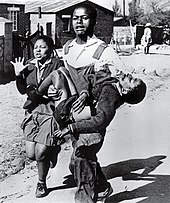"Bring back Nelson Mandela,
Bring Him Back home to Soweto
I want to see him walking down the streets of South Africa tomorrow!"
 |
| The broadway musical, Sarafina! (also later made into a movie), made Masekela's song even more popular |
These famous words from the song, Bring Him Back Home by
Hugh Masekela ran through my mind as we drove into Soweto on a recent visit to South Africa. It wasn't a tourist trip as one might assume. I accompanied a friend, who accompanied a friend who was invited by another friend to tag along while he visited his friend who lived in Soweto. That's a lot of friendships. Fortunately, the friend who was driving, understood that it's not everyday that a foreigner gets to visit Soweto (when not on a guided tourist trip). Hence my friend and I got to tag along with our other friend.
 |
| The FNB Stadium in Soweto (known as Soccer City during the FIFA 2010 World Cup) |
As a Zambian, I am very proud of the role that my country played in the liberation of Southern Africa, and especially of South Africa. The comradeship that characterised our leaders' relationships in the 50s and 60s is perhaps something that can never be recaptured.
 |
| June 16, 1976 -- Hector Pieterson being carried after being shot |
Being in Soweto also brought to mind the
Soweto Uprising of June 16th, 1976. In the rest of Africa, this day is commemorated as
The Day Of the African Child as designated by the African Union (then Organisation of African Unity - OAU) in 1991. That day is remembered by the iconic picture of a boy named Hector Pieterson, who was shot and later died as police fired on school children protesting the government's newly introduced policy to teach in Afrikaans. We didn't visit the
Hector Pieterson museum, but we did see the sign.
 |
| The museum is that way |
We also passed by the famous Regina Mundi church, where many of the children in the Soweto uprising ran to for safety. Because public gatherings were banned, the church was the only place where black South Africans could legally meet. As such, many meetings and discussions took place within the sacred walls of this particular catholic church.
 |
| Soweto's Iconic Landmark Feature -- the Orlando Power Station Cooling Towers |
The Orlando Power Station cooling towers is one of the most iconic Soweto images. They appear almost everywhere that Soweto is depicted. One tower contains South Africa's largest mural paintings, while the other is a massive advertising billboard. The towers were decommissioned several years ago, but they are the site of bungee jumping and other adrenaline sports.
 |
| Winnie Mandela's House |
Naturally, we swung by Winnie Mandela's house too. There really wasn't much to see, other than the glaring absence of the Zambian flag. I will give them the benefit of the doubt and conclude that it was being washed.
 |
| Can you guess who the main residents of the Soweto sub-township of Lenasia are? |
It was interesting to be in a place to which we were once all so connected. It represented an ideal -- that until we are all free, then none of us in African are free. Walking and driving through the streets of Soweto, so many things were familiar. It is Africa after all. From the roadside businesses and advertisements showcasing everything and anything, to the people gathered around a mechanic's having a drink. The hairdresser's is always a busy place and there is one on every corner, just like you will find grocery stores, churches and Coca Cola containers. The school playgrounds look pretty much like they do back home. Everybody avoids being crammed four-four in the back seat of the mini-buses that they call taxis here.
 |
| Slag heaps from years of mining are a familiar sight to any Zambian from the Copperbelt |
At the same time, while a lot of what I saw was the same, it was also very different. Off the top of my head, two examples come to mind: 1. The varying levels of affluence within the township are much more evident than in Lusaka or Kitwe. 2. The dressing is quite different too. Women wear shorter skirts and dresses -- not as short as in town, but definitely shorter than back home.
.








No comments:
Post a Comment